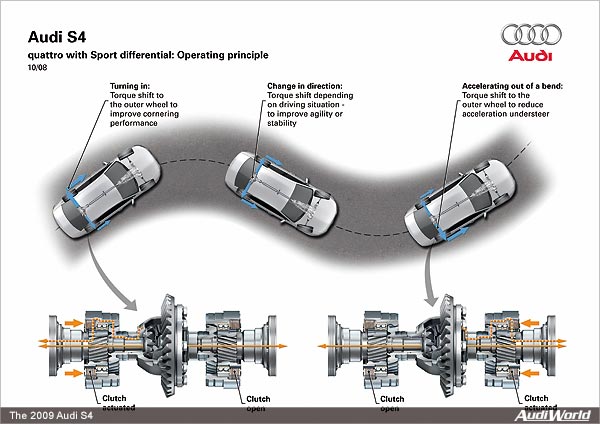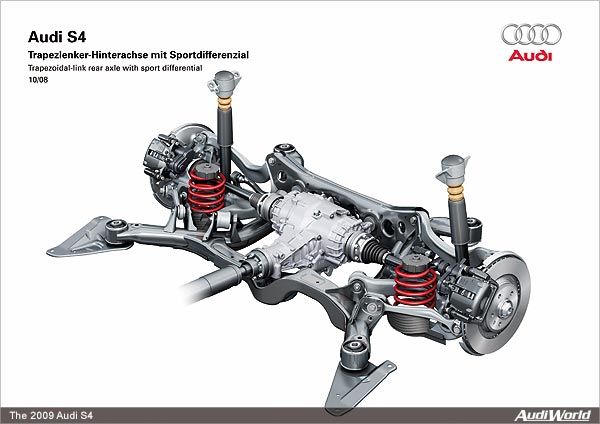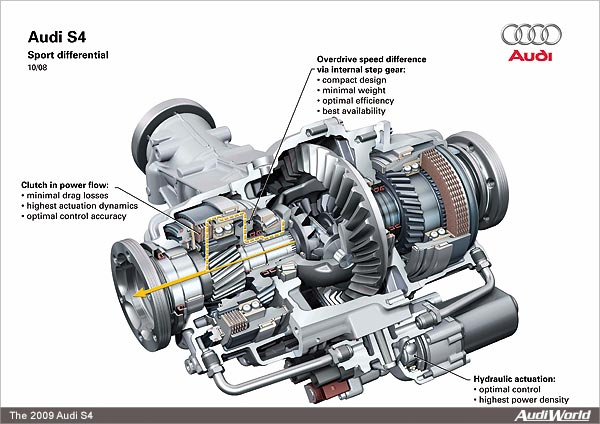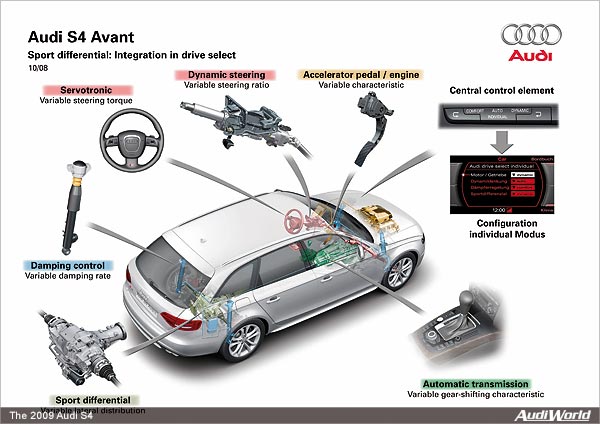The Audi S4: quattro Drive and Sport Differential
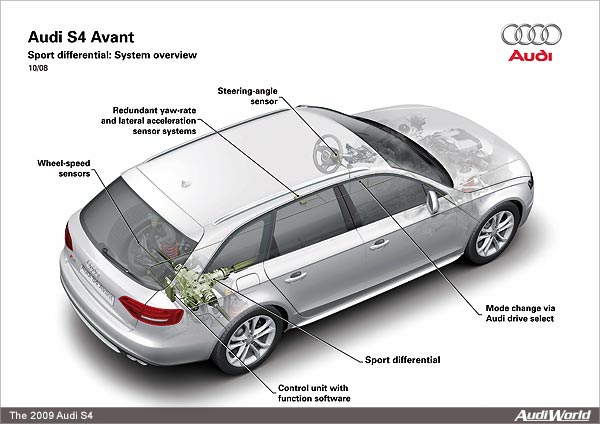
This exceptionally good traction puts the quattro system at an extremely high level as far as dynamics in a forward direction are concerned. But quattro technology also has distinct advantages in terms of lateral dynamics. By distributing traction among all four wheels, each wheel has greater potential to resist lateral forces, and tire grip is maintained for significantly longer. The action of the electronic differential lock (EDL) and the typical Audi settings adopted for the ESP electronic stabilization system also add to driving pleasure and a high level of stability.
Lateral dynamics redefined
Both when the steering wheel is turned and when accelerating in a corner, vehicles with conventional drive to the axles tend to understeer for as long as the tires have adequate grip. The laws of physics cause a moving body to resist any change of direction initially. When a vehicles steering is turned away from a straight line, the tires and suspension pivots absorb some of the initial movement before the direction changes. When accelerating in a corner, the front axle load is reduced and therefore less lateral force can be transmitted to the tires: the vehicle understeers and is forced out onto a larger-radius curve.
With its active sport differential, Audi elevates the road dynamics of cars with quattro permanent four-wheel drive to a new level. The innovative control system distributes the drive torque in continuously variable proportions between the rear wheels if necessary, it diverts virtually all the power to just one of the two wheels thereby achieving a substantial increase in agility, driving pleasure and active driving safety. This targeted control of the power flow causes the vehicle to turn even more spontaneously and directly into bends, as well as endowing it with much longer-lasting directional stability. The sport differential is not only effective under load but also when the car is coasting. Even when the clutch is depressed, agility-enhancing torque distribution is active.
As if on rails
With the active sport differential driving the rear wheels, the car quite literally takes every corner as if on rails. Depending on the steering angle, lateral acceleration, yaw angle, road speed and other signals, the control unit calculates the most suitable distribution of torque to the wheels for every driving situation. When the steering wheel is turned, for example, or the car accelerated in a corner, power is redirected in a controlled manner to the outer rear wheel. This has the effect of forcing the car into the corner so that the angle of the front wheels is followed accurately. The difference in tractive force between the left and right wheels also exerts a steering effect, so that the usual corrections by the driver at the steering wheel are no longer needed. Understeer, that is to say the tendency for the car to run wide at the front, is completely eliminated.
When driven briskly along a typical country road, the car follows the successive bends in a manner similar to the precise track formed by carving skis in the snow. The sport differential redistributes the power input continually with great rapidity and counteracts any tendency for the car to understeer or oversteer before either of these effects can build up. For the driver, this means reduced effort at the steering wheel and higher maximum lateral acceleration.
A notable safety bonus
Close to the cars handling limits, the sport differential acts like ESP, but with the principle reversed: corrective movements are not initiated solely by altering the engine settings or applying the brakes, but also by controlled redistribution of tractive force. The cars progress is distinctly smoother and free-flowing, its actual road dynamics and those sensed subjectively by the driver are both enhanced, and driving pleasure benefits too, since ESP comes into action much less frequently. Since its reaction time is extremely short less than 100 milliseconds the sport differential takes effect even more rapidly than ESP. Furthermore, ESP can only react to a discrepancy between the cars steering angle and its actual body rotation, whereas the sport differential influences the cars dynamic behavior before any such discrepancies occur.
Active torque distribution is based on an entirely new design principle for the rear-axle differential. So that the new high-tech unit can also divert torque to the outer wheel on the axle, which revolves faster than the inner wheel when cornering, the classic rear-axle differential has superimposed stages at the left and right, and a multi-plate clutch running in an oil bath. The clutches are activated by an electro-hydraulic actuator.
Superimposed stages for acceleration
The superimposed output stage rotates ten percent faster than the half-shaft that normally drives the wheel; the two drivelines can be connected together by the multi-plate clutch. If the clutch is engaged, the wheel is accelerated by the superimposed stage that is running at a higher speed, and thus receives an additional torque input. The differential reduces the tractive force reaching the opposite wheel accordingly. In most driving situations, almost the complete input torque can be diverted to one rear wheel in this way. The maximum difference in torque between the wheels is 1,800 Newton-meters (1327.61 lb-ft).
The sport differential is even capable of completely eliminating the classic load-reversal reactions when the accelerator is lifted or the brakes applied suddenly while cornering; the driver can specify this function by selecting comfort mode. If the accelerator pedal is released, torque distribution between the wheels is adjusted almost instantaneously.
Unlike other systems, the Audi sport differential is just as effective when the engine is driving the wheels as it is on the overrun or when the car is coasting freely. In simplified terms, here too one wheel is braked and the other accelerated with the aid of the superimposed drive stages. This diverts the torque to the wheels and the vehicle is given a precisely calculated impulse in the required direction.
A technically superior solution
The task of distributing a high level of torque with minimum losses by way of a transmission that is compact and light in weight was an extremely challenging one. The solution arrived at by Audis engineers is as ingenious as it is innovative. A new transmission stage, consisting of two sun wheels and a ring gear, performs the task in a very simple fashion. The ingenuity lies in the fact that the ring gear is displaced in relation to the sun wheels. The resulting generous gear tooth overlap enables torque transfer to take place using a minimum number of components. This is the first time that this principle has been used in a road-vehicle driveline.
The system needs no maintenance throughout its life, and operates at a high level of efficiency. The additional fuel consumption needed for the active sport differential is so small that it is hardly measurable. The device takes effect extremely quickly and has a very high level of control accuracy.
Thanks to its control unit, the sport differential is an intelligent unit. Audi developed the necessary software, which uses a unique operating principle, in-house. The computer obtains the information it needs from the steering angle, wheel speed, lateral acceleration and yaw-rate sensors and from current engine data. Twin yaw-rate and lateral acceleration sensors are installed for the sport differential. This explains the systems extremely high reaction speed: data from both sensors are continuously compared in the control unit, which means that reliable results are available more rapidly.
Audi drive select the unique high-tech package
The quattro driveline with active sport differential is part of Audi drive select, the innovative dynamic driving system premiered on the new Audi A4. As part of an optimal combination with Audi dynamic steering and electronic shock absorber control, the permanent four-wheel driveline and the sport differential demonstrate their immense capabilities with regard to driving dynamics.
Audi drive select integrates the technical components that determine the quality of the driving experience: engine, transmission, steering, shock absorbers and the sport differential. Drivers can adjust the characteristics of these systems at any time to suit their personal preferences. Audi drive select is a successful synthesis of comfort and convenience with dynamic sportiness at a previously unattained level.
Buttons on the centre console enable drivers to vary the operation of Audi drive select in three stages ranging from comfortable to sporty, or to put together a profile that suits their personal preferences. The engines throttle response characteristic can be determined first, followed by that of the servotronic speed-dependent power steering and, if the car has automatic transmission, its shift points.
Three operating modes for the sport differential
The functions of the sport differential can also be varied to suit the drivers individual wishes. In the comfort mode, driving safety and the cars stability have absolute priority, with optimal damping of load reversals. In the auto mode the program achieves a harmonious balance between all the functions. Finally, the dynamic mode emphasizes the functions contributing towards agility, so that the dynamic effect of the sport differential is most easily felt. In this case, response to load reversals is both agile and easily controllable.
The equipment, data, and prices specified refer to the models offered in Germany. Subject to amendment; errors and omissions excepted.
|

